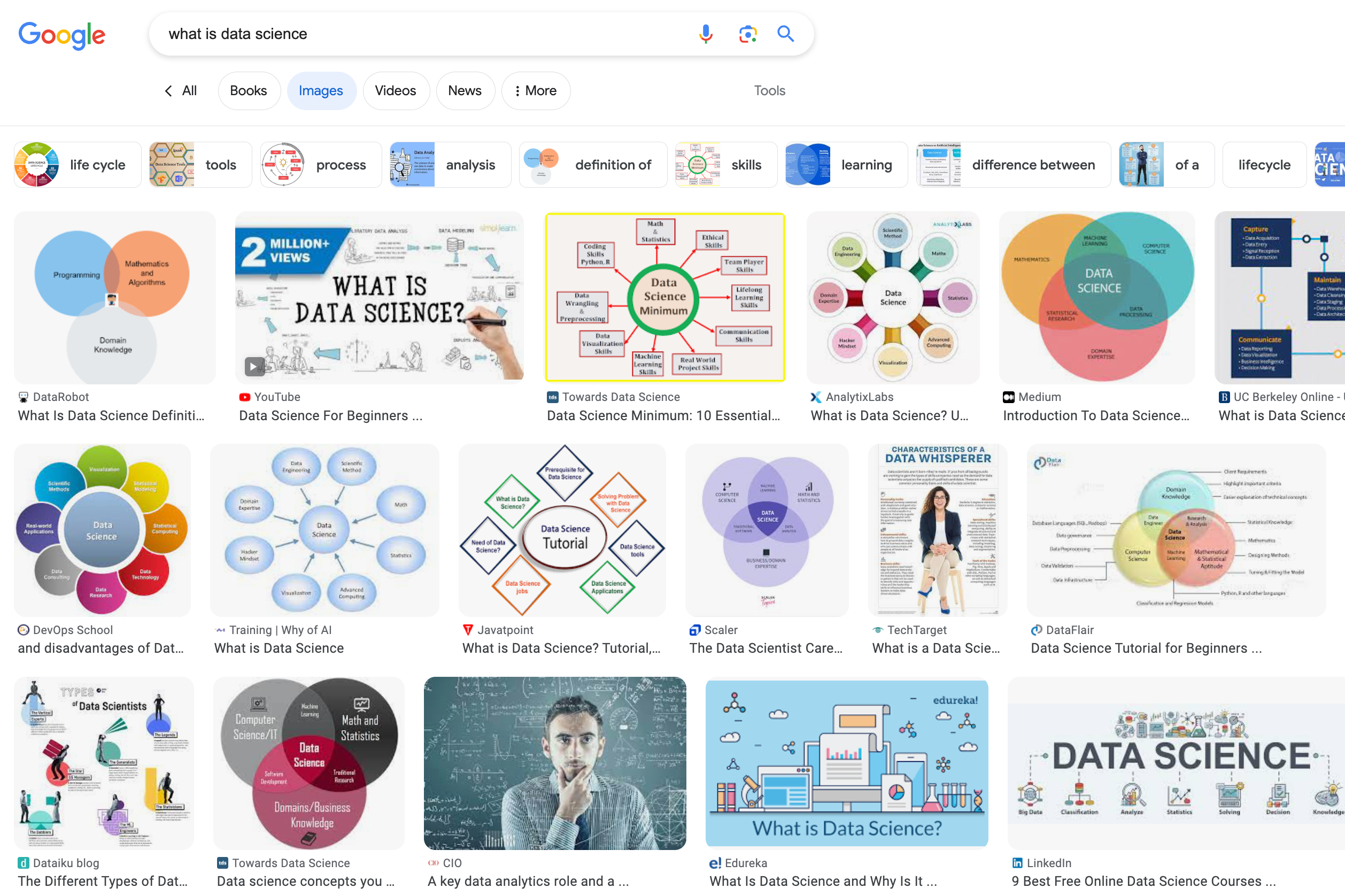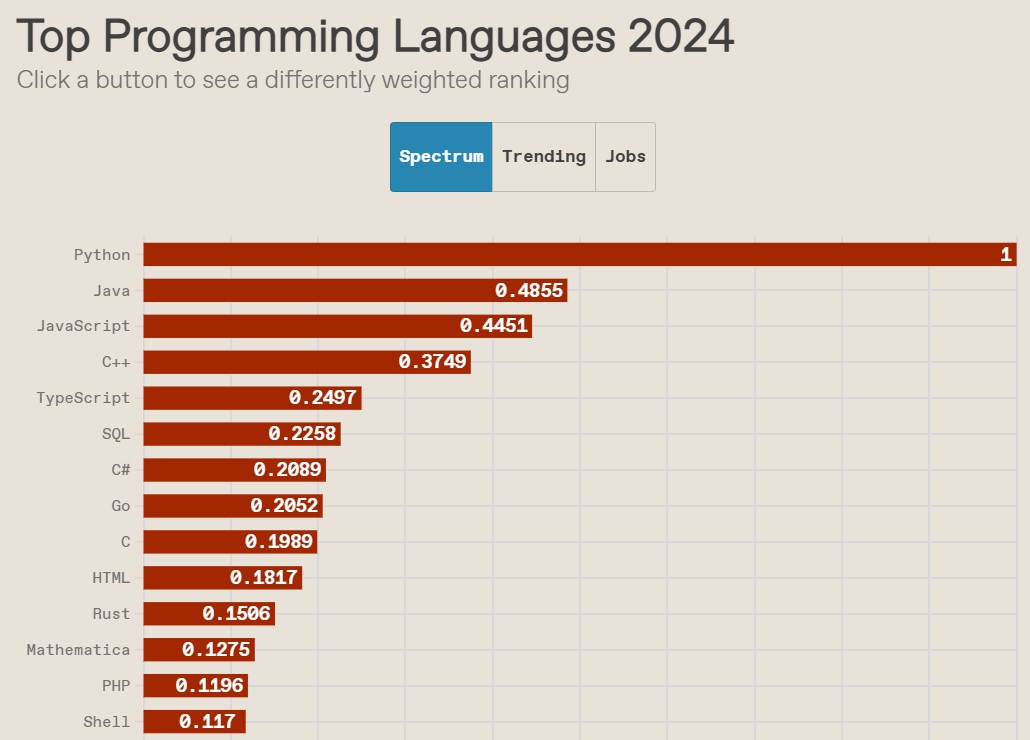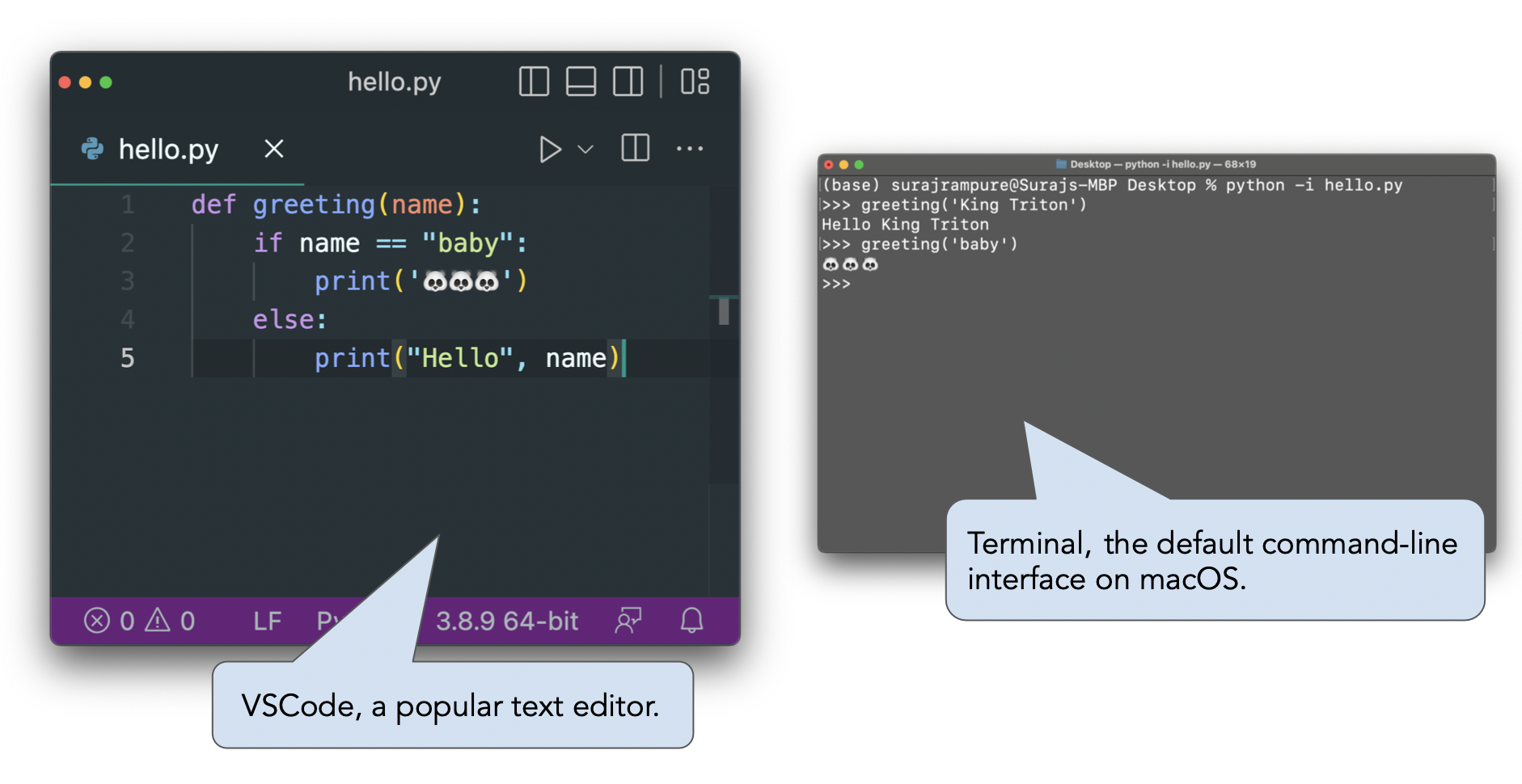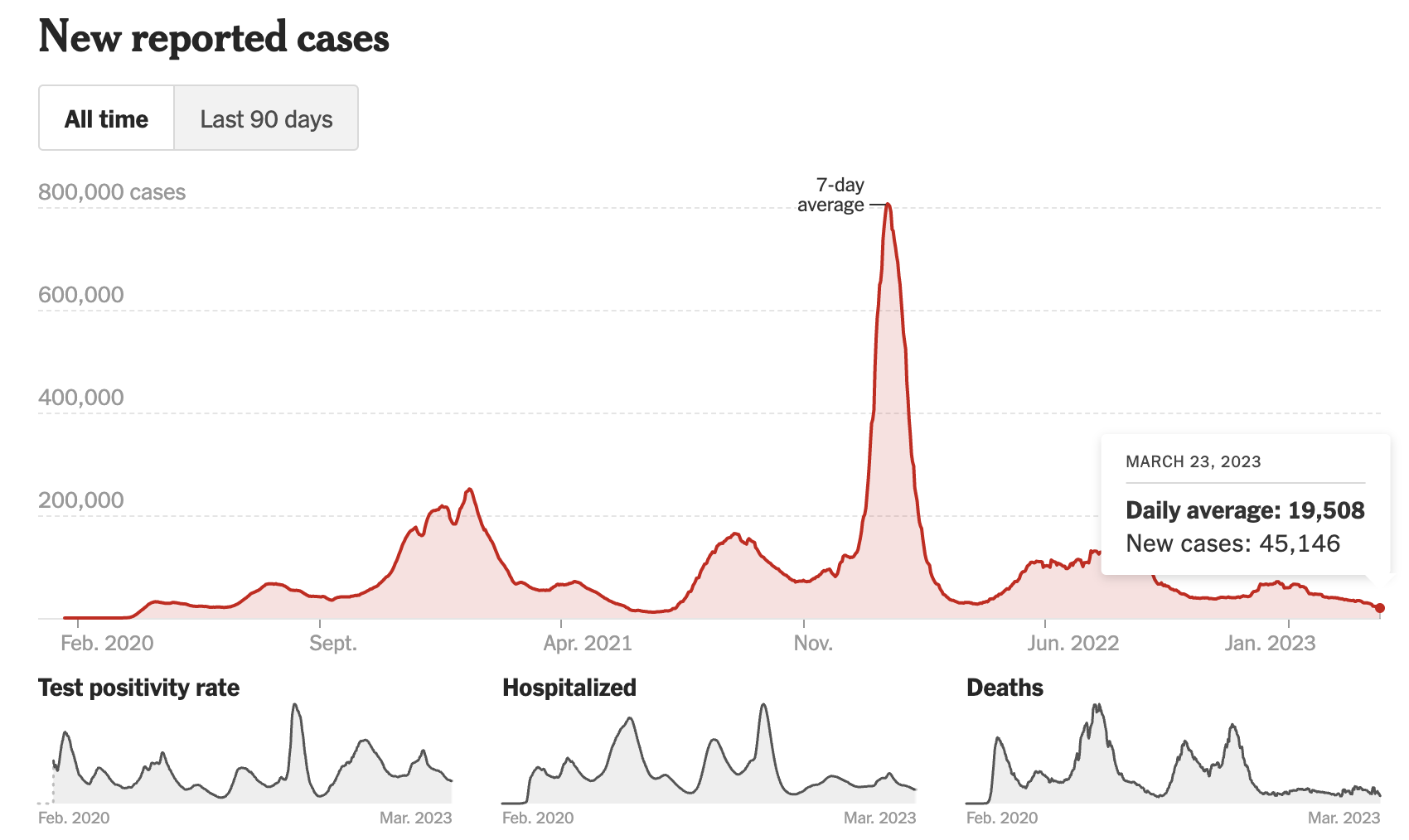# Run this cell to set up packages for lecture.
import babypandas as bpd
import matplotlib.pyplot as plt
import numpy as np
plt.style.use("ggplot")
Welcome to DSC 10! 👋¶
- DSC 10 is a guided tour of data science.
- It was developed by UC Berkeley in 2015 and adapted by UCSD in 2017.
- You'll learn just enough programming and statistics to do data science.
- We'll cover statistics without too much math – instead, we'll use simulation.
- This class lays the foundation for all other courses in the DSC major.
Agenda¶
- Course staff.
- What is data science?
- How will this course run?
- Fun demo.
- What is code? What are Jupyter Notebooks?
- Expressions.
Course staff¶
Instructor: Dr. Peter Chi (call me Peter)¶
- PhD in Biostatistics from the University of Washington.
- Teaching Experience: Cal Poly SLO ➡️ Ursinus College ➡️ Villanova University ➡️ UCSB ➡️ UCSD.
- 13th year of teaching!
- New to UCSD this year.
- Outside interests: practicing Mandarin, watching basketball, hanging out with my 5 year old.
 |
 |
 |
Instructor: Dr. Sam Lau (call me Sam)¶
- BS + MS in Electrical Engineering and Computer Science at UC Berkeley, PhD in Cognitive Science at UCSD 🔱.
- 3rd year of teaching.
- Mostly teach DSC 106 (Data Vis), and DSC 80.
- Outside interests: cooking / cocktail-making, board games, NBA, woodworking, music festivals, playing with my dogs Bentley and Tulip.
 |
 |
 |
 |
 |
 |
 |
Course staff¶
In addition, we have many other course staff members who are here to support you in discussion, office hours, and online.
- Graduate TA: Hemanth Bodala
- Graduate Reader: Minchan Kim
- Undergraduate tutors: Kate Feng, Bianca Grunbaum, Michelle Hong, Avi Mehta, Sofia Tkachenko, Raymond Williams.
- Stuffed panda mascot: Baby Panda. 🐼
Learn more about them at dsc10.com/staff, and come say hi in office hours!
What is "data science"? 🤔¶
 Everyone seems to have their own definition of data science.
Everyone seems to have their own definition of data science.What is "data science"?¶
Data science is about drawing useful conclusions from data using computation. Throughout the quarter, we'll touch on several aspects of data science:
- First 4 weeks: use Python to explore data.
- Lots of visualization 📈📊 and "data manipulation", using industry-standard tools.
- Next 4 weeks: use data to infer about a population, given just a sample.
- Rely heavily on simulation, rather than formulas.
- Last 2 weeks: use data from the past to predict what may happen in the future.
- A taste of machine learning 🤖.
It can be fun, too!¶
The site The Pudding is home to several interactive data-rich articles.
 (source)
(source)Course logistics¶
Important Dates¶
We will have four quizzes, two exams, and two optional knowledge assessments for research this quarter. All will be conducted in person and on paper.
- Research Assessment 1: Friday, January 16
- Quiz 1: Friday, January 23rd
- Quiz 2: Friday, February 6th
- Midterm Exam: Wednesday, February 11th during lecture
- Quiz 3: Friday, February 27th
- Quiz 4: Friday, March 6th
- Research Assessment 2: Friday, March 13
- Final Exam: Saturday, March 14th from 8:00AM to 11:00AM
Let us know of any conflicts and share your availability for course meetings on the Welcome Survey.
Getting started¶
Your first task is to complete the following by Wednesday, Jan 7th at 11:59PM.
- Join Campuswire (join code: 6304).
- Check if you can access Gradescope. If not, send a private message to the instructional staff on Campuswire with your name, PID, and email address, then we can add you so you can submit assignments.
- Read the syllabus and course website and complete the Syllabus Check.
- Fill out the Welcome Survey.
Academic Integrity policies¶
Collaboration¶
- Discuss all questions with each other (except, of course, on quizzes and exams).
- Projects are submitted in pairs or individually. Both partners should contribute to all parts of the project, not split it up.
- Labs and homeworks are submitted individually.
- No other person should complete your work for you or write any of the code you submit in this course, with the exception of the work you do with a project partner.
- Don't give someone else your code or look at someone else's code.
Generative Artificial Intelligence (GenAI)¶
- The syllabus includes a discussion of these tools and how you may use them in this class. Please read this carefully, ask questions about it, and proceed with care!
Getting help¶
This is a tough, fast-paced course, but we're here to help you – here's how:
- Office Hours (OH).
- Not held in an office, but in a large open study space.
- Come with questions, or just to work!
- See the schedule and instructions on the 📆 Calendar.
- Campuswire.
- Post here with any logistical or conceptual questions; please don't email or use Canvas.
- No code or solutions in public posts. Such posts should be private to course staff.
- Otherwise, post publicly (anonymously, if you'd like).
- Resources, Resources, Resources.
- The course website includes links to course notes, a reference sheet, tutor-created videos and slideshows, interactive diagrams, practice exams with solutions, and more.
- 🚨 Important: Use these to your advantage!
Advice from previous students¶
At the end of each quarter, we ask DSC 10 students to give advice to future students in the course. Here are some responses from past students:
Start the assignments (especially the midterm/final projects) early! It became so manageable with more time to split up sections and think things through without a crazy overbearing time pressure.
Be prepared to spend a lot of time in this class, regardless of whether you have any prior knowledge in programming or statistics. Everything is doable, but you will need to put in a significant amount of effort to succeed and sometimes you'll have to think outside of the box to come up with solutions.
Go to office hours!! It is the best resource available. The tutors are more than willing to help you out. The tutors made my time at DSC 10 not only manageable but also enjoyable. Also, prepare for the quizzes at least one day in advance so that you can retain the material better.
Practice is the most important thing you can do to succeed in this course. Also, grab a friend - two (or more) heads are better than one! And don't be afraid to ask for help when needed.
We're here for you!¶
Regardless of your background, you can succeed in this course with lots of hard work. No prior programming or statistics experience will be assumed! We'll start at the beginning, but we will move fast!
Inspirational TED talk: 🎥 We’re All Data Scientists by Rebecca Nugent.
Wellness resources¶
Research Projects¶
- We will be conducting research studies using data collected from this course.
- Participation in these research studies is completely optional and will not affect your grade in this course.
- If you choose to participate, your involvement will help us learn how to better teach students like yourself.
- Insights from this work may be published to contribute to the broader public and academic community.
- One of our research projects involves deploying a custom-built AI tutor for DSC 10.
- This AI tutor is available to you for free through DataHub.
- For more information about our research projects, including opt-out information, visit: https://dsc10.com/research
Demo¶
Little Women (1868)¶
- Little Women, by Louisa May Alcott, is a novel that follows the life of four sisters – Meg, Jo, Beth, and Amy.
- A movie based on the novel was released in 2019, starring Emma Watson (Meg) and Timothée Chalamet (Laurie).
- Using tools from this class, we'll learn (a bit) about the plot of the book, without reading it.
- Do not worry about any of this code – we'll cover the necessary pieces in the weeks to come. Sit back and relax!
# Read in 'lw.txt' to a variable called little_women_text.
little_women_text = open("data/lw.txt").read()
# See the first three thousand characters.
little_women_text[:3000]
'The Project Gutenberg EBook of Little Women, by Louisa May Alcott\n\nThis eBook is for the use of anyone anywhere at no cost and with\nalmost no restrictions whatsoever. You may copy it, give it away or\nre-use it under the terms of the Project Gutenberg License included\nwith this eBook or online at www.gutenberg.net\n\n\nTitle: Little Women\n\nAuthor: Louisa May Alcott\n\nPosting Date: September 13, 2008 [EBook #514]\nRelease Date: May, 1996\n[This file last updated on August 19, 2010]\n\nLanguage: English\n\n\n*** START OF THIS PROJECT GUTENBERG EBOOK LITTLE WOMEN ***\n\n\n\n\nLITTLE WOMEN\n\n\nby\n\nLouisa May Alcott\n\n\n\n\nCONTENTS\n\n\nPART 1\n\n ONE PLAYING PILGRIMS\n TWO A MERRY CHRISTMAS\n THREE THE LAURENCE BOY\n FOUR BURDENS\n FIVE BEING NEIGHBORLY\n SIX BETH FINDS THE PALACE BEAUTIFUL\n SEVEN AMY\'S VALLEY OF HUMILIATION\n EIGHT JO MEETS APOLLYON\n NINE MEG GOES TO VANITY FAIR\n TEN THE P.C. AND P.O.\n ELEVEN EXPERIMENTS\n TWELVE CAMP LAURENCE\n THIRTEEN CASTLES IN THE AIR\n FOURTEEN SECRETS\n FIFTEEN A TELEGRAM\n SIXTEEN LETTERS\n SEVENTEEN LITTLE FAITHFUL\n EIGHTEEN DARK DAYS\n NINETEEN AMY\'S WILL\n TWENTY CONFIDENTIAL\n TWENTY-ONE LAURIE MAKES MISCHIEF, AND JO MAKES PEACE\n TWENTY-TWO PLEASANT MEADOWS\n TWENTY-THREE AUNT MARCH SETTLES THE QUESTION\n\n\nPART 2\n\n TWENTY-FOUR GOSSIP\n TWENTY-FIVE THE FIRST WEDDING\n TWENTY-SIX ARTISTIC ATTEMPTS\n TWENTY-SEVEN LITERARY LESSONS\n TWENTY-EIGHT DOMESTIC EXPERIENCES\n TWENTY-NINE CALLS\n THIRTY CONSEQUENCES\n THIRTY-ONE OUR FOREIGN CORRESPONDENT\n THIRTY-TWO TENDER TROUBLES\n THIRTY-THREE JO\'S JOURNAL\n THIRTY-FOUR FRIEND\n THIRTY-FIVE HEARTACHE\n THIRTY-SIX BETH\'S SECRET\n THIRTY-SEVEN NEW IMPRESSIONS\n THIRTY-EIGHT ON THE SHELF\n THIRTY-NINE LAZY LAURENCE\n FORTY THE VALLEY OF THE SHADOW\n FORTY-ONE LEARNING TO FORGET\n FORTY-TWO ALL ALONE\n FORTY-THREE SURPRISES\n FORTY-FOUR MY LORD AND LADY\n FORTY-FIVE DAISY AND DEMI\n FORTY-SIX UNDER THE UMBRELLA\n FORTY-SEVEN HARVEST TIME\n\n\n\nCHAPTER ONE\n\nPLAYING PILGRIMS\n\n"Christmas won\'t be Christmas without any presents," grumbled Jo, lying\non the rug.\n\n"It\'s so dreadful to be poor!" sighed Meg, looking down at her old\ndress.\n\n"I don\'t think it\'s fair for some girls to have plenty of pretty\nthings, and other girls nothing at all," added little Amy, with an\ninjured sniff.\n\n"We\'ve got Father and Mother, and each other," said Beth contentedly\nfrom her corner.\n\nThe four young faces on which the firelight shone brightened at the\ncheerful words, but darkened again as Jo said sadly, "We haven\'t got\nFather, and shall not have him for a long time." She didn\'t say\n"perhaps never," but each silently added it, thinking of Father far\naway, where the fighting was.\n\nNobody spoke for a minute; then Meg said in an altered tone, "You know\nthe reason Mother proposed not having any presents this Christmas was\nbecause it is going to b'
# Print the first three thousand characters.
print(little_women_text[:3000])
The Project Gutenberg EBook of Little Women, by Louisa May Alcott
This eBook is for the use of anyone anywhere at no cost and with
almost no restrictions whatsoever. You may copy it, give it away or
re-use it under the terms of the Project Gutenberg License included
with this eBook or online at www.gutenberg.net
Title: Little Women
Author: Louisa May Alcott
Posting Date: September 13, 2008 [EBook #514]
Release Date: May, 1996
[This file last updated on August 19, 2010]
Language: English
*** START OF THIS PROJECT GUTENBERG EBOOK LITTLE WOMEN ***
LITTLE WOMEN
by
Louisa May Alcott
CONTENTS
PART 1
ONE PLAYING PILGRIMS
TWO A MERRY CHRISTMAS
THREE THE LAURENCE BOY
FOUR BURDENS
FIVE BEING NEIGHBORLY
SIX BETH FINDS THE PALACE BEAUTIFUL
SEVEN AMY'S VALLEY OF HUMILIATION
EIGHT JO MEETS APOLLYON
NINE MEG GOES TO VANITY FAIR
TEN THE P.C. AND P.O.
ELEVEN EXPERIMENTS
TWELVE CAMP LAURENCE
THIRTEEN CASTLES IN THE AIR
FOURTEEN SECRETS
FIFTEEN A TELEGRAM
SIXTEEN LETTERS
SEVENTEEN LITTLE FAITHFUL
EIGHTEEN DARK DAYS
NINETEEN AMY'S WILL
TWENTY CONFIDENTIAL
TWENTY-ONE LAURIE MAKES MISCHIEF, AND JO MAKES PEACE
TWENTY-TWO PLEASANT MEADOWS
TWENTY-THREE AUNT MARCH SETTLES THE QUESTION
PART 2
TWENTY-FOUR GOSSIP
TWENTY-FIVE THE FIRST WEDDING
TWENTY-SIX ARTISTIC ATTEMPTS
TWENTY-SEVEN LITERARY LESSONS
TWENTY-EIGHT DOMESTIC EXPERIENCES
TWENTY-NINE CALLS
THIRTY CONSEQUENCES
THIRTY-ONE OUR FOREIGN CORRESPONDENT
THIRTY-TWO TENDER TROUBLES
THIRTY-THREE JO'S JOURNAL
THIRTY-FOUR FRIEND
THIRTY-FIVE HEARTACHE
THIRTY-SIX BETH'S SECRET
THIRTY-SEVEN NEW IMPRESSIONS
THIRTY-EIGHT ON THE SHELF
THIRTY-NINE LAZY LAURENCE
FORTY THE VALLEY OF THE SHADOW
FORTY-ONE LEARNING TO FORGET
FORTY-TWO ALL ALONE
FORTY-THREE SURPRISES
FORTY-FOUR MY LORD AND LADY
FORTY-FIVE DAISY AND DEMI
FORTY-SIX UNDER THE UMBRELLA
FORTY-SEVEN HARVEST TIME
CHAPTER ONE
PLAYING PILGRIMS
"Christmas won't be Christmas without any presents," grumbled Jo, lying
on the rug.
"It's so dreadful to be poor!" sighed Meg, looking down at her old
dress.
"I don't think it's fair for some girls to have plenty of pretty
things, and other girls nothing at all," added little Amy, with an
injured sniff.
"We've got Father and Mother, and each other," said Beth contentedly
from her corner.
The four young faces on which the firelight shone brightened at the
cheerful words, but darkened again as Jo said sadly, "We haven't got
Father, and shall not have him for a long time." She didn't say
"perhaps never," but each silently added it, thinking of Father far
away, where the fighting was.
Nobody spoke for a minute; then Meg said in an altered tone, "You know
the reason Mother proposed not having any presents this Christmas was
because it is going to b
# Create a variable "chapters" by splitting the text on 'CHAPTER '.
chapters = little_women_text.split("CHAPTER ")
# Create a DataFrame with one column - the text of each chapters.
bpd.DataFrame().assign(chapters=chapters)
| chapters | |
|---|---|
| 0 | The Project Gutenberg EBook of Little Women, b... |
| 1 | ONE\n\nPLAYING PILGRIMS\n\n"Christmas won't be... |
| 2 | TWO\n\nA MERRY CHRISTMAS\n\nJo was the first t... |
| 3 | THREE\n\nTHE LAURENCE BOY\n\n"Jo! Jo! Where ... |
| 4 | FOUR\n\nBURDENS\n\n"Oh, dear, how hard it does... |
| ... | ... |
| 43 | FORTY-THREE\n\nSURPRISES\n\nJo was alone in th... |
| 44 | FORTY-FOUR\n\nMY LORD AND LADY\n\n"Please, Mad... |
| 45 | FORTY-FIVE\n\nDAISY AND DEMI\n\nI cannot feel ... |
| 46 | FORTY-SIX\n\nUNDER THE UMBRELLA\n\nWhile Lauri... |
| 47 | FORTY-SEVEN\n\nHARVEST TIME\n\nFor a year Jo a... |
48 rows × 1 columns
# Number of occurrences of each name in each chapter.
counts = bpd.DataFrame().assign(
Amy=np.char.count(chapters, "Amy"),
Beth=np.char.count(chapters, "Beth"),
Jo=np.char.count(chapters, "Jo"),
Meg=np.char.count(chapters, "Meg"),
Laurie=np.char.count(chapters, "Laurie"),
)
counts
| Amy | Beth | Jo | Meg | Laurie | |
|---|---|---|---|---|---|
| 0 | 0 | 0 | 0 | 0 | 0 |
| 1 | 23 | 26 | 44 | 26 | 0 |
| 2 | 13 | 12 | 21 | 20 | 0 |
| 3 | 2 | 2 | 62 | 36 | 16 |
| 4 | 14 | 18 | 34 | 17 | 0 |
| ... | ... | ... | ... | ... | ... |
| 43 | 31 | 8 | 61 | 3 | 29 |
| 44 | 13 | 0 | 9 | 0 | 10 |
| 45 | 1 | 2 | 6 | 2 | 0 |
| 46 | 2 | 1 | 56 | 4 | 2 |
| 47 | 10 | 3 | 37 | 6 | 13 |
48 rows × 5 columns
# Cumulative number of times each name appears.
cumulative_counts = bpd.DataFrame().assign(
Amy=np.cumsum(counts.get("Amy")),
Beth=np.cumsum(counts.get("Beth")),
Jo=np.cumsum(counts.get("Jo")),
Meg=np.cumsum(counts.get("Meg")),
Laurie=np.cumsum(counts.get("Laurie")),
Chapter=np.arange(1, 49, 1),
)
cumulative_counts
| Amy | Beth | Jo | Meg | Laurie | Chapter | |
|---|---|---|---|---|---|---|
| 0 | 0 | 0 | 0 | 0 | 0 | 1 |
| 1 | 23 | 26 | 44 | 26 | 0 | 2 |
| 2 | 36 | 38 | 65 | 46 | 0 | 3 |
| 3 | 38 | 40 | 127 | 82 | 16 | 4 |
| 4 | 52 | 58 | 161 | 99 | 16 | 5 |
| ... | ... | ... | ... | ... | ... | ... |
| 43 | 619 | 459 | 1435 | 673 | 571 | 44 |
| 44 | 632 | 459 | 1444 | 673 | 581 | 45 |
| 45 | 633 | 461 | 1450 | 675 | 581 | 46 |
| 46 | 635 | 462 | 1506 | 679 | 583 | 47 |
| 47 | 645 | 465 | 1543 | 685 | 596 | 48 |
48 rows × 6 columns
# Putting it all together, we get a helpful visualization.
import plotly.express as px
cumulative_counts_df = (
cumulative_counts.drop(columns=["Chapter"])
.to_df()
.melt()
.rename(columns={"variable": "name", "value": "Count"})
)
cumulative_counts_df = cumulative_counts_df.assign(
Chapter=list(range(1, 49)) * 5
)
px.line(
cumulative_counts_df,
x="Chapter",
y="Count",
color="name",
width=900,
height=600,
title="Cumulative Number of Times Each Name Appears",
template="ggplot2",
)
- In Chapter 32, Jo moves to New York alone. Her relationship with which sister suffers the most from this faraway move?
- Laurie is a man who marries one of the sisters at the end. Which one?
What is code? What are Jupyter Notebooks? 💻¶
What is code?¶
- Instructions for computers are written in programming languages, and are referred to as code.
- “Computer programs” are nothing more than recipes: we write programs that tell the computer exactly what to do, and it does exactly that – nothing more, and nothing less.
Why Python?¶
- It's popular!
 (source and
methodology)
(source and
methodology)
- It has a variety of use cases. Some examples:
- Web development.
- Data science and machine learning.
- Scripting and automation.
- It's (relatively) easy to dive right in! 🏊
Jupyter Notebooks 📓¶
- Often, but not in this class, code is written in a text editor and then run in a command-line interface (or both steps are done in an IDE).

- Jupyter Notebooks allow us to write and run code within a single document. They also allow us to embed text and code. We will be using Jupyter Notebooks throughout the quarter.
- DataHub is a server that allows you to run Jupyter Notebooks from your web browser without having to install any software locally.
Aside: Lecture slides¶
- The lecture slides you're viewing right now are also in the form of a Jupyter Notebook – we're just using an extension (called RISE) to make them look like slides.
- When you click a lecture DataHub link on the course website, you'll see the lecture notebook in regular notebook form.
- To view it in slides form, click the bar chart button in the toolbar.
 This button!
This button!Expressions¶
Python as a calculator¶
- An expression is a combination of values, operators, and functions that evaluates to some value.
- For now, let's think of Python like a calculator – it takes expressions and evaluates them.
- We will enter our expressions in code cells. To run a code cell, either:
- Hit
shift+enter(orshift+return) on your keyboard (strongly preferred), or - Press the "▶ Run" button in the toolbar.
- Hit
23
23
-15 + 2.718
-12.282
4**3
64
(2 + 3 + 4) / 3
3.0
# Only one value is displayed. Why?
9 + 10
13 / 4
21
21
Arithmetic operations¶
| Operation | Operator | Example | Value |
|---|---|---|---|
| Addition | + |
2 + 3 |
5 |
| Subtraction | - |
2 - 3 |
-1 |
| Multiplication | * |
2 * 3 |
6 |
| Division | / |
7 / 3 |
2.33333 |
| Remainder | % |
7 % 3 |
1 |
| Exponentiation | ** |
2 ** 0.5 |
1.41421 |
Python uses the typical order of operations – PEMDAS (BEDMAS? 🛏️)¶
5 * 2**3
40
(5 * 2) ** 3
1000
Activity¶
In the cell below, write an expression that's equivalent to
$$(19 + 6 \cdot 3) - 15 \cdot \left(\sqrt{100} \cdot \frac{1}{30}\right) \cdot \frac{3}{5} + \frac{4^2}{2^3} + \left( 6 - \frac{2}{3} \right) \cdot 12 $$
Try to use parentheses only when necessary.
Summary, next time, reminders¶
Summary¶
- Expressions evaluate to values. Python will display the value of the last expression in a cell by default.
- Python knows about all of the standard mathematical operators and follows PEMDAS.
Next time¶
- We'll learn how to use variables to store values so that we can use them later in our code.
- We'll compute values using functions like
max,min, andround. - We'll discover that there are multiple different ways of storing values in Python. These are called data types.
Reminders¶
- Complete the items in the Getting Started section of the syllabus by Wednesday, Jan 7th at 11:59PM.
- Then, work the Pretest and Lab 0, both due Mon, Jan 12th at 11:59PM. Access assignments by clicking links from the homepage of dsc10.com.
